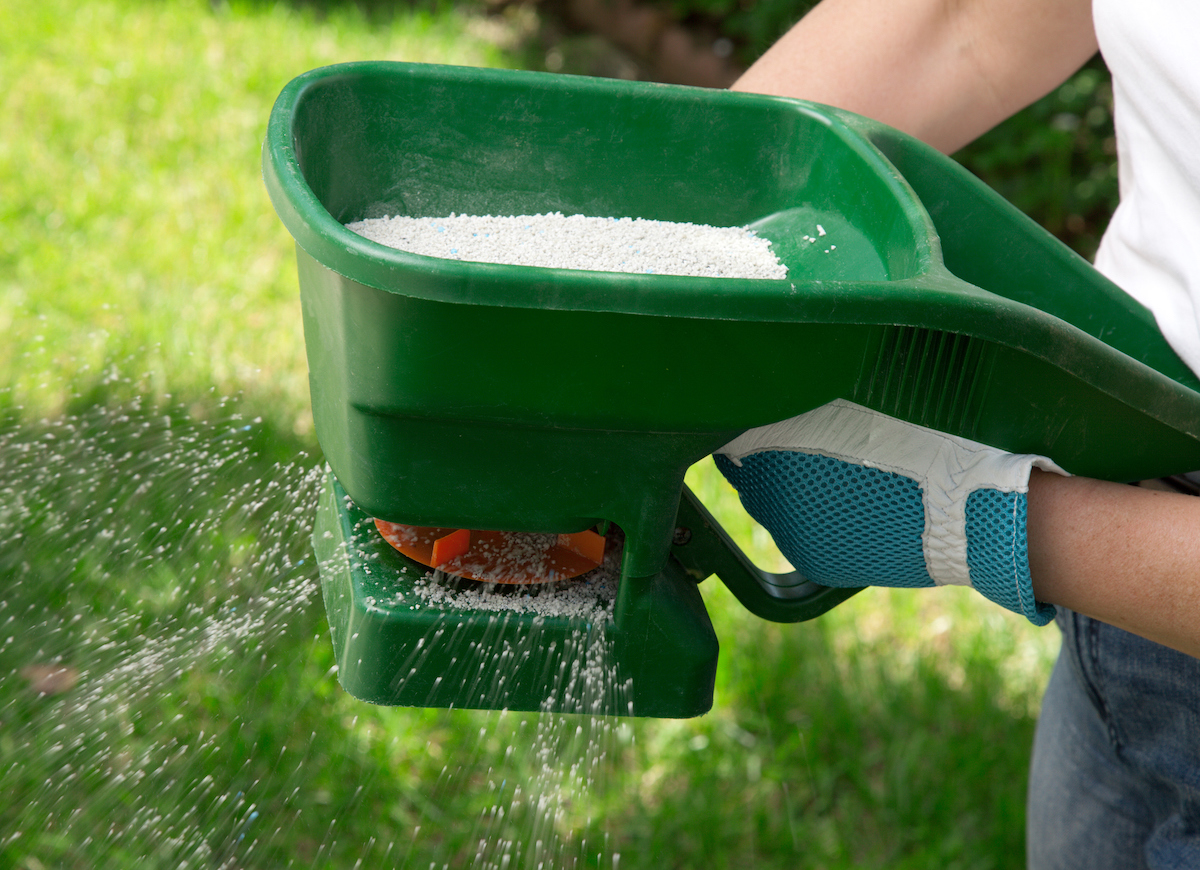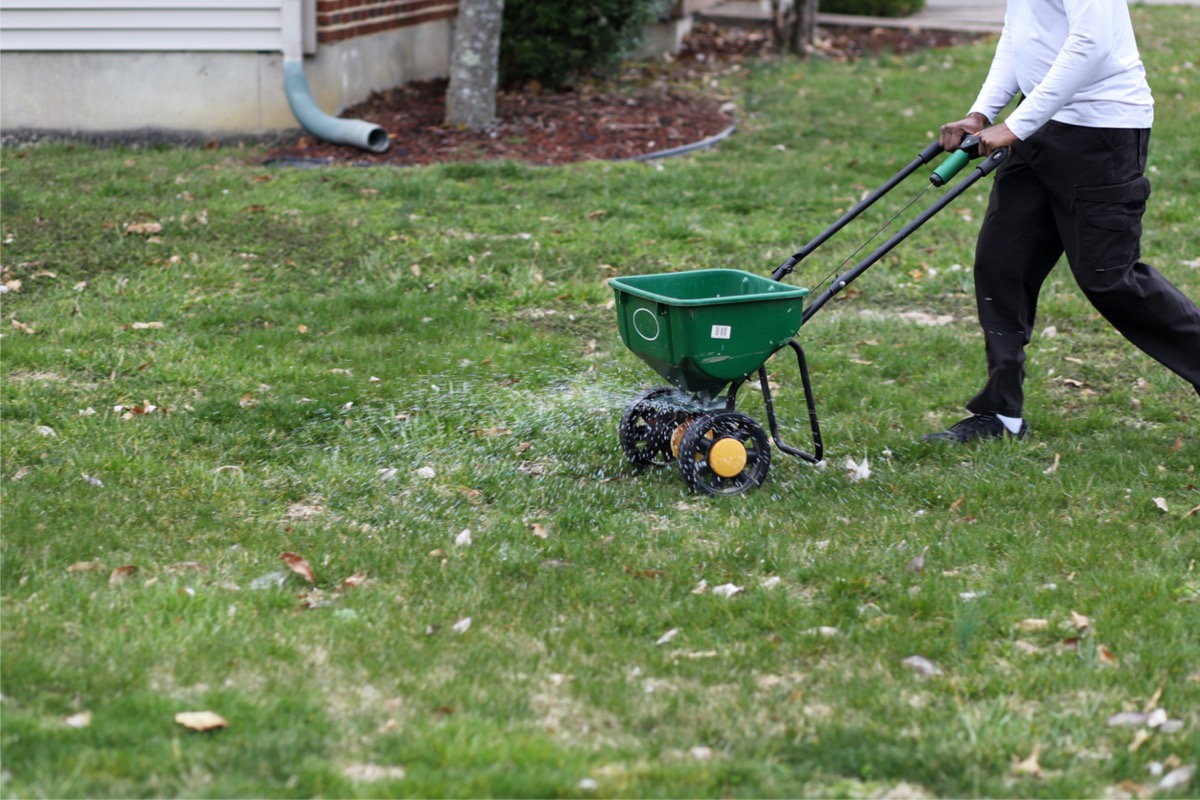

We may earn revenue from the products available on this page and participate in affiliate programs. Learn More ›
Q: Help! Last year, our lawn was brown and not as healthy-looking as it could have been. When should I fertilize the grass to ensure a lush, green lawn this year?
A: As the saying goes, “The grass is always greener on the other side of the fence.” But if this year you want that green lawn on your side, fertilizer can be an effective ally. Keep in mind that the question of when to apply fertilizer is just as important as how much.
Generally speaking, you should fertilize your lawn at least twice a year to ensure good overall health and keep your grass looking its greenest. But if you fertilize at the wrong time or over-treat your lawn, you could encourage weed growth, or possibly burn the grass.
To avoid damaging your lawn, consider this rule of thumb: The best time to apply lawn fertilizer is when your grass is actively growing—and this, in turn, is determined by where you live and what type of grass you have.
So, to figure out when you should fertilize, you need to know your grass type, your growing zone, and the best fertilizer for the job.

The first step in timing your fertilizer application is to identify your grass type.
In the United States, there are two primary types of grasses: warm-season grasses and cool-season grasses. There’s also a cross-section of grasses that are considered transitional, which means that they can be grown successfully in parts of the country that are typically too warm for cool-season grasses and too cool for warm-season grasses. Your lawn fertilizing schedule will depend on the type of grass you have, but remember that it takes constant commitment to any routine to guarantee year-after-year success.

- Cool-season grasses are prevalent in the northern parts of the United States, and varieties like Kentucky bluegrass, tall and fine fescues, and ryegrass are the most common. Cool-season grasses prefer lower temperatures and have two peak growing periods: one in the early spring, just after winter dormancy, and another in the early fall. High summer temperatures and lack of water may cause cool-weather grasses to go dormant until chilly temps arrive and water is more readily available.
- Warm-season grasses thrive in the southern region of the United States. These grasses benefit from warm temperatures, which means that midsummer is their ideal growing season. These grasses are tough, and they form a thick lawn cover that becomes denser over time. The four major types of warm-season grasses are Bermuda grass, centipede grass, St. Augustine grass, kikuyu grass, and zoysia grass.
- If you live in a transitional zone, you may have a combination of warm- and cool-season grasses that will require different care at different times. A clue to figuring out your grass type is to keep a lookout for how your lawn behaves. Warm-season grasses turn brown after the first frost, while cool-season grasses generally stay green all year long in the cool and transitional zones. They will not, however, survive the summer months if the temperatures become excessively high.
RELATED: Bob Vila’s Definitive Lawn Care Calendar

Once you identify your grass type, you can figure out when to give your grass fertilizer.
Each type of grass has its own growing season and requires a different lawn fertilizer schedule.
- The primary growing period for cool-season grasses is during the spring and fall, when average temperatures are between 60 and 70 degrees Fahrenheit. To ensure optimal health, fertilize heavily in the fall and lightly in early spring. You can choose either slow- or quick-release fertilizer types, but be sure to apply the treatment before the temperatures peak in summer, when these grasses will most likely go dormant. Cool-season grasses need only 1 to 2 pounds of nitrogen-rich fertilizer per 1,000 square feet per year. As you’re planning out your lawn-care routine, note that there are special winter fertilizers available at your local gardening center that are formulated to help protect your grass during cold months.
- The optimal growing period for warm-season grasses is late spring and summer, when temperatures average 80 to 95 degrees Fahrenheit. As growth may begin below or above this temperature range, keep an eye on your lawn and time spring fertilization for when the grass just starts turning green. Warm-season grasses should be fed 3 to 4 pounds of nitrogen-rich fertilizer per 1,000 square feet of lawn per year. You can choose between slow- or quick-release fertilizer types, but be sure the application is fully absorbed before the onset of high temperatures. After applying the fertilizer, water the grass thoroughly, washing the grains off the blades of grass and into the soil to be sure that the soil fully absorbs the treatment, but don’t water so thoroughly that you create runoff. Apply a second round of fertilizer once the peak summer heat has passed.
RELATED: Types of Fertilizer For Your Lawn and Garden
Avoid applying nitrogen-rich fertilizer when your lawn is dormant.
Nitrogen, a key component of fertilizer, contains a growth stimulant that could increase unwanted weed growth if it is applied during dormancy. If you’ve endured a long winter and the grass is not yet growing, don’t be afraid to delay your scheduled fertilizer treatment.
RELATED: After 8 Weeks of Testing, We Found the Best Weed and Feed
Read the product label.
Before buying lawn fertilizer, scrutinize product labels to find out how long each product is formulated to last. Some time-release products will slowly distribute nutrients over a 2- to 8-month period, so leave sufficient time between applications to avoid overfertilizing, which could damage your lawn.

Don’t fertilize during a drought.
If you’re under water restrictions as a result of drought, hold off on fertilizing. Most fertilizers need a thorough watering or two to soak into the soil, and allowing the fertilizer to sit on top of the lawn without watering it in could burn the grass. You may want to delay the application until wet weather arrives.
RELATED: The Best Drought-Resistant Grass for Dry Summers
Don’t apply fertilizer right after a rainstorm.
If a rainstorm has recently soaked your lawn and saturated the soil, wait a day or two before fertilizing the grass. This will allow the ground to dry out some so you don’t create runoff—and wasted fertilizer—when you water in the fertilizer. Applying fertilizer to dry grass also ensures a better chance that the fertilizer will slide down to the soil rather than sticking to the blades of grass.
The best time to fertilize grass is when the ground warms up to 55 degrees Fahrenheit.
When winter begins to yield to springtime and ground temperatures hit 55 degrees Fahrenheit for a run of 4 or 5 days, dormant plants, including grass, begin their spring surge of activity. This is the best time to fertilize. Fertilizing before then will be a wasted effort.
When fall rolls around, typical fall ground temperatures should be just fine for fertilizer application. But if it’s chilled down after a frost, you’ve missed your window. In that case, you’ll have to wait until the following spring.

Avoid fertilizing your grass with certain products after seeding your lawn.
If you’ve just reseeded your lawn, it’s OK to apply fertilizer, but you’ll want to use a product specifically designed for the reseeding period. These fertilizers are sometimes called “starter” fertilizers, and they have a 1:1 (or close to that) nitrogen to phosphorus ratio.
Seeds need phosphorus to develop strong roots and enable the plant to fight disease. Nitrogen is used for leaf development, so you’ll use a nitrogen-rich fertilizer about 6 to 8 weeks after seeding.
If you are seeding a brand-new lawn, the best practice is to fertilize your soil with starter fertilizer before you spread seed. This is a good time to check general soil health, which can be done with a readily available soil test kit.

